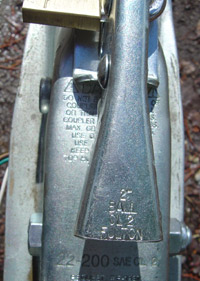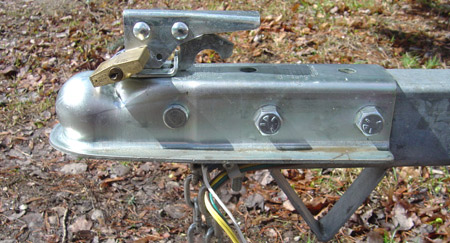Boat Trailer Hitch: Choosing The Best Towing Hitches For Your Vehicle
There are a number of key points to consider when assembling a boat trailer hitch.
The first piece of information you need to check is your vehicle tow capacity.
If towing is all new to you start by making sure the tow vehicle you wish to use has a towing capacity that will safely tow the weight of the boat and trailer you intend to pull. Check your vehicle owners manual, and add up the weight of your boat and trailer - add a few pounds for fuel and gear in the boat as well.
Don't start spending money on a boat trailer hitch and wiring if your vehicle is not powerful enough to tow the weight of the trailer and boat. Remember you will need to back this rig down a sloping launch ramp and if your tow vehicle is not powerful enough you may not be able to pull the boat and trailer back up the launch ramp, especially if it is a slippery one! For example: I would say a vehicle rated for 3500 lbs towing and a boat with trailer weighing 3000 lbs is not powerful enough.
Or worse... if your vehicle is too light for the trailer you tow, especially if the trailer does not have brakes, you may get pushed through a red light one rainy day by the weight of your boat and trailer behind you.
The parts of a boat trailer hitch include: tow vehicle hitch, receiver, ball, coupler, safety chains, and electrical connector.
- Tow vehicle hitch
The tow vehicle must have a hitch mounted to the back which will accept a receiver.The hitch must be rated to tow the weight you expect to tow.
Hitch manufacturers in North America include: Hidden Hitch, Reese, Draw-Tite, Valley, Curt, and U-haul. All these companies make vehicle specific hitches that simply bolt on to existing bumper or frame bolt holes on the vehicle.
Hitches by these manufacturers are engineered to meet automotive safety regulations. This is a good thing!
- Receiver and ball
The receiver will attach to the vehicle hitch to allow you to bolt on the proper sized ball. Different drops or lifts are available on receivers to allow you to compensate for any difference in height between the tow vehicle and trailer. Make sure you install the correct size ball on the receiver to match the coupler on your trailer.
Make sure you install the correct size ball on the receiver to match the coupler on your trailer.On the coupler it tells you what size ball is required. This is an important point! I have heard enough stories of people trying to use a 1-7/8 inch ball with a 2 inch coupler only to have their trailer come unhitched while driving. Not fun!
Use the correct size ball!
- Boat Trailer Coupler
On the front of the trailer is the coupler (the gizmo which attaches to the ball on the vehicle).Inside the coupler is only one moveable part which is designed to clamp to the underside of the ball to create a ball and socket joint between the tow vehicle and the trailer. This clamp gets pulled up or pushed forward into position with a lever or bolt system. Make sure the clamp is in the correct position.
If your trailer is pushing toward the tow vehicle while you are hitching it up it may be hard to close the clamp, or if it is a bolt system you may think it is tight when in reality the clamp is just hard to do up.
I have a utility trailer with an older hand tighten bolt clamping system on the coupler.... I have to be very sure that it is properly done up.
With small trailers it is easy to lift on the coupler or trailer tongue to make sure the ball is properly secured in the coupler. Take a look underneath the coupler to make sure it is done up correctly.
The lever on the coupler will have a lock hole. Once it is in the closed position make sure you put a padlock or locking pin of some type on it (hitch pin, wire lock pin, cotter pin, snapper pin, tab-lock pin) to make sure it does not come open while driving.

- Boat Trailer Safety Chains
A boat trailer hitch must have safety chains which are permanently attached to the trailer , and can be attached to the tow vehicle hitch while towing in case the ball and coupler come apart while driving.
The chains should be crossed under the trailer hitch and attached to the vehicle on the opposite side of the ball/coupler assembly. Regulations in different countries, provinces and states may require different systems for attaching the safety chains. Make sure your equipment meets your local regulations.
Once you get used to attaching a boat trailer hitch coupler to a vehicle hitch ball you will know what to watch for.
Don't get complacent. Check check and double check, or you will be paying for costly vehicle and boat damage.
This information is just to get you started.... if you have never towed a boat trailer before, get advice from a person who can walk you through the process.
Safety first!
Return from Boat Trailer Hitch to Boat Trailer Parts
Return to My Inflatable Boat.com
 Make sure you install the correct size ball on the receiver to match the coupler on your trailer.
Make sure you install the correct size ball on the receiver to match the coupler on your trailer.
